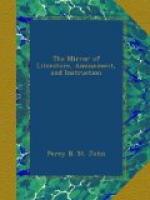[11] These have been engraved by
Mr. Carter, for his Specimens
of Ancient Sculpture, together with the Brass
in memory
of John de Campden, &c.
The pavement throughout the church is still chiefly composed of glazed tiles, “called and supposed to be Roman; though upon some of them we clearly see the hatched and other Saxon ornaments,” and upon others the monosyllables HAVE MYNDE (Remember) in the black letter characters used in the fifteenth century. There are passages running round each story, and communicating with the tower; but, “with all its magnificence, the general aspect of the interior is sadly disfigured by a thick coating of yellow ochre.” (The Crypt.)
Such is the venerable pile of St. Cross, surrounded by some of the finest scenery in the county. Our Correspondent P.Q. earnestly observes “it was in and near this hospital that he was educated; in its noble church he was a chorister, and his feelings of veneration for the whole establishment, dedicated to the highest of Christian virtues, will never be effaced.” Would that every heart beamed with so amiable a sense of gratitude. Reverting to the ancient purposes of the foundation it is to be feared they are not realized with the poet’s prediction: that
Lasting charity’s
more ample sway,
Nor bound by time, nor subject to decay,
In happy triumph shall for ever live.—PRIOR.
* * * * *
THE NATURALIST.
* * * * *
THE PEARL IN THE OYSTER.
Cowper eloquently says
There is glory in the grass, and splendour in the flower;
and the imagery might have been extended to the irridescent pearl within the rudely-formed shell of the oyster. Poets have feigned that pearls are
Rain from the
sky,
Which turns into pearls as it falls in
the sea;
we need scarcely add that science has exploded this imaginative fertility.
Pearl is, in fact, a calcareous secretion by the fish of bivalve shells; and principally by such as inhabit shells of foliated structure, as sea and fresh water muscles, oysters, &c. A pearl consists of carbonate of lime, in the form of nacre, and animal matter arranged in concentric layers around a nucleus; the solution indicating no trace of any phosphate of lime. To this lamellar structure the irridescence is to be ascribed. Each layer is presumed to be annual; so that a pearl must be of slow growth, and those of large size can only be found in full-grown oysters. The finest and largest are produced from the Meleagrina margaratifera, (Lamarck,) a native of the sea, and of various coasts. A considerable number are likewise taken from the Unio margaratifera, which inhabits the rivers of Europe; and, it is singular, as remarked by Humboldt, that though several species of this genus abound in the rivers of South America, no pearls are ever found in them. The pearls are situated in the body of the oyster, or they lie loose between it and the shell; or, lastly, they are fixed to the latter by a kind of neck; and it is said they do not appear until the animal has reached its fourth year.




